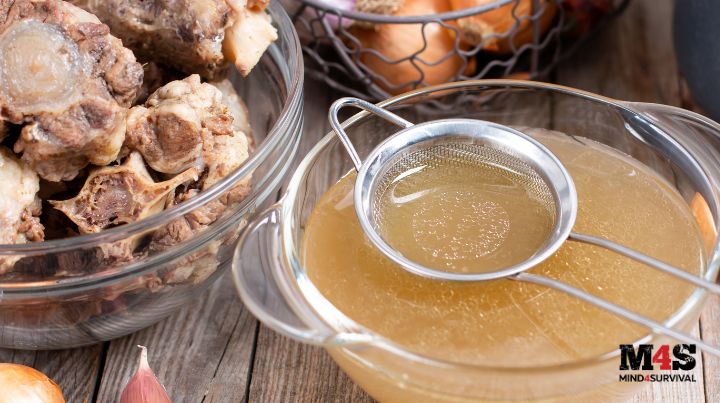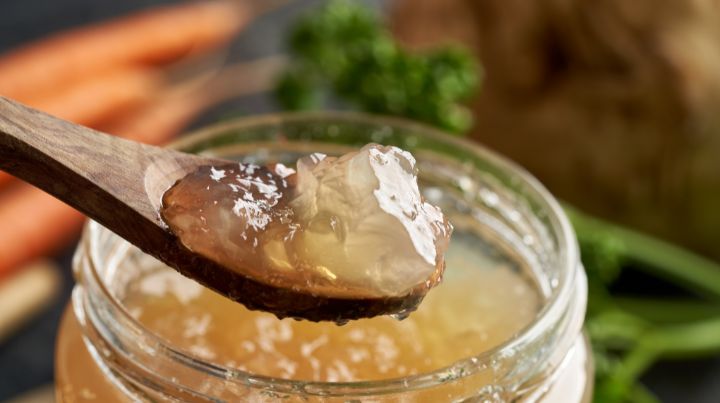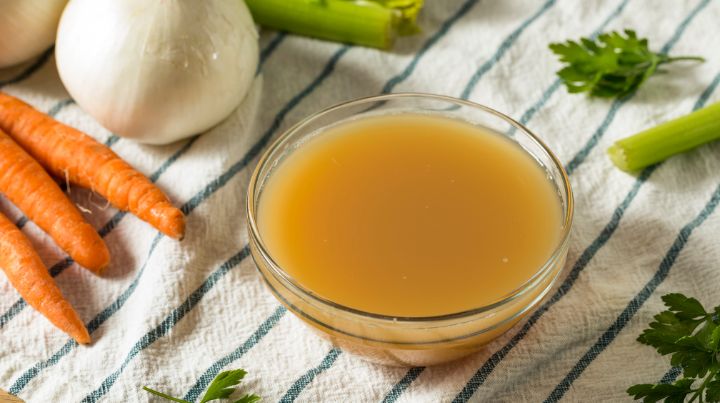Homemade Bone Broth: Here’s How To Make It

Do you want to assemble a pantry? Are you trying to determine which healthy foods require little preparation to enjoy? If so, consider adding jars of homemade bone broth. Having jars of broth on hand can liven up freeze-dried foods and turn dried snacks into meals. If you’ve never made broth from scratch before, read on to learn how to make and use this cheap, nutritious, versatile food.
How to Make Homemade Bone Broth
Making bone broth is really simple. It just takes a lot of time. Simmering for eight hours is a bare minimum; I typically shoot for about twelve. The extended cooking time allows cartilage and gelatin from the bones to dissolve, making the broth extra nutritious.
Start with bones. If you buy a half or whole pig, steer, or lamb, most butchers toss these in if asked beforehand. If you have friends that hunt, ask them to save bones for you. You can make broth from anything; I’ve got a pot of deer bones simmering on my stove as I write.
If you buy meat at the store, many stores sell soup bones, but they are not necessarily cheap.
However, if you regularly prepare meat, you have probably noticed that bone-in cuts are cheaper than boneless. If you eat meat off the bones, save the bones and use those for stock.
In fact, this is how my foray into soup-making began. I wasn’t out in the country, eating home-raised meat; I was a suburban mom with young children looking to pinch pennies. We bought a lot of chicken because whole chickens were really cheap at the time, and we tossed all the bones into Ziploc bags after eating. Bones from the carcasses of two chickens were enough for one pot of soup. I boiled the bones with one or two tablespoons of an acidic substance (either vinegar or lemon juice), which helped to dissolve the nutrients within the bones, and that was all it took to create a delicious soup base.
You can also simmer your broth with fresh vegetables. I make broth in larger batches now. If I am simmering three or four pounds of beef, lamb, deer, or pork bones, I will usually add two onions and two celery roots with their leaves.
Whether or not you roast the bones beforehand is a matter of preference. Roasting the bones gives the broth a stronger, richer flavor, but it is an extra step. It’s not absolutely essential.
Keep an Eye on the Foam!
As you simmer, pay attention to the foam that forms. If you want a perfectly clear stock, you will need to skim it off. If you skip this step, understand that the broth will be cloudy and that if it sits for an extended period of time, it may develop an off flavor.
Once you’ve simmered for the desired length of time, you’ll need to cool it down. I do the overwhelming majority of my broth-making in the winter months because I can simply put my pot in the shed and let it cool off there overnight. If this isn’t an option for you, you can put it in an ice bath before putting it in the fridge.

The next day, any fat in the meat should have risen to the top. Lift this off and save it to use for browning meat in other recipes. If your broth has a jello-like consistency, this is desirable. It means there is a lot of gelatin in the bones you used, which is very nutritious. At this point, you can use your broth in recipes or prepare it for storage.
How to Store Homemade Bone Broth
Freezing is by far the easiest way to store broth. Once it’s cooled, put it into quart containers for easy measuring and keep it in your freezer for months.
However, if you want off-grid options, pressure-canning is my other go-to. It is not idiot-proof. Broth is a low-acid food, which means that improper canning may lead to botulism. You must use a pressure canner. However, pulling a jar of home-canned broth off the shelf is such a quick way to have a delicious, nutritious meal that I believe it is a worthwhile skill to pursue.
I have never freeze-dried broth, but according to the Harvest Right Freeze Dryers manufacturers, it’s another option.
If you don’t have money in the budget for a freeze dryer or a pressure canner, if you are short on freezer space, you could also consider boiling your broth down until it is thick and syrupy to concentrate it.
Benefits
Whether you are building a pantry to prepare for food shortages, some kind of extreme SHTF situation, or simply because you don’t want to have to run out to the store when a storm blows through, broth is a great addition. It will turn the dried beans, rice, and veggies you probably already have into nutritious meals. It really is the perfect ingredient that ties everything else together.
Broth is also incredibly beneficial for your health. If you want to dive deeply into the science behind why broth has been an essential part of the human diet for millennia, Sally Fallon Morell’s book Nourishing Broths is fascinating and informative.
If you want a quick rundown of the health benefits of broth, conventional medical websites like WebMD and HealthLine both give summaries.
The most commonly cited health benefits of bone broth are:
- Improved hydration
- Improved digestion
- Improved sleep patterns
- Relief from joint pain
Some people have reported relief from autoimmune symptoms after regularly consuming bone broth. I am one of them; homemade soup with broth from well-raised animals is our first line of defense in maintaining the household’s health, and so far, it has served us well.
Final Thoughts
Maintaining a well-stocked pantry gets painted as something for crazy hoarders, but this is simply not true. I live in an area with pioneer descendants; many come from families that have been in the habit of maintaining a pantry for generations. For people my grandparents’ age, in certain parts of the country, it was not easy to get to a store for most of the winter, and keeping several months of food on hand was simply part of good housekeeping.
Those who had a long family practice of maintaining pantries gained eager listeners during the pandemic; I couldn’t find flour in my town for four months in 2020 and became far more aware of how much food my family actually went through.
While this is a survival website, the goal is not just to survive whatever life throws at us, but to thrive. Sure, people can survive scavenging off whatever they can find, and many do. But if you’re trying to plan for the future and want to be as well prepared as possible, why not plan on putting away the best possible food you can?
Broth made with bones simmered over a long period of time will not only taste great but also help keep your family healthy. It is an excellent addition to any pantry, and if you’ve never made your own broth before, why not begin keeping bones from your meat and give it a try?
Additional Resources:
- DIY: Rendering Fat at Home
- Preppa Pig: Raising Pork As A Prep
- Freeze-Drying Pros and Cons (From an Owner!)
- I Swapped My Clothes for Year-Round Wool

Don't Miss Out!
Join the thousands of people who rely on Mind4Survival preparedness advice by subscribing to our FREE newsletter.
- Practical preparedness information
- Zero Spam
- < 0.25% of people unsubscribe




Join Mind4Survival!
Stay informed by joining the Mind4Survival! 100% Secure! 0% Spam!
Follow Us!
Affiliate Disclosure
Mind4Survival is a free, reader-supported information resource. If you make a purchase through our link, we may, at no cost to you, receive an affiliate commission.



Good information on broth. I have been making my own broth for years using a pressure cooker to cook down the bones and prepare the broth. Cuts the time needed to get good breakdown. Once ready I can the result using pressure canning following all the guidelines for safe canning of low acid foods. Never had a problem.